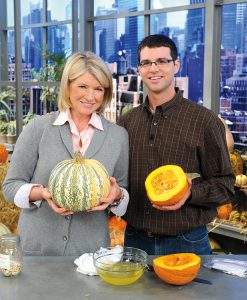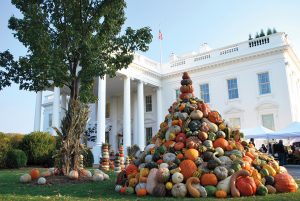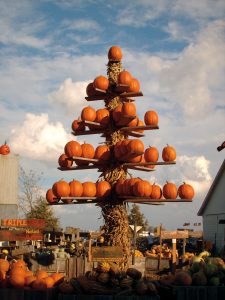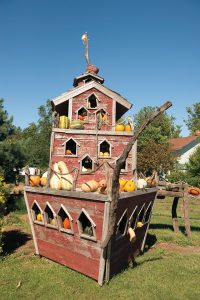To say Mac Condill’s life’s work started with a seed would be trite but true.
As a boy, he loved putting his arms around a pumpkin from the family’s patch, hoisting it onto the kitchen table, and digging into the center with his mother’s spoon. He never imagined his love of the smooth squash would someday get him an invitation to the White House or a chance to chat up Martha Stewart on national television.
Appears InMac ’99 grew up in Illinois Amish country, where people wave and skinny roads stretch past modest homes with vegetable gardens and clotheslines.
He is a twin and one of three boys. A high school valedictorian, he majored in psychology at a private college in Indiana. It didn’t take him long to miss The Great Pumpkin Patch, a business started on his family’s 200-acre farm in 1989.
After driving by a greenhouse near his college, he stopped and asked to work there. “I didn’t have enough green in my life,” he said. Watering plants two days a week still wasn’t enough. He looked for options after his freshman year and found Illinois State University’s horticulture program. He met with former horticulture professor Ann Marie VanDerZanden. “She was just on fire for horticulture, and I knew this is what I had to do,” he said.
During his sophomore year at ISU, Mac applied for a highly competitive internship in Scotland, but he didn’t get it. He applied again as a junior and was chosen. As much as he liked the idea of living in a castle and rolling his wheelbarrow around a 55-acre garden, he didn’t want to delay graduation. He met with Jeff Wood, then College of Applied Science and Technology dean (CAST), and developed a plan. Mac soaked up agribusiness and horticulture classes, graduated summa cum laude, and went back to the farm.
He was ready to lead, having strengthened management traits that were obvious to family members even in his youth. Dad Bruce Condill loves telling the story of Mac leaving a to-do list before going to school. It outlined how many ears of Indian corn needed to be picked, adding “When I get home from school, if these things were done, that would be awfully nice.”
Now 40, Mac owns The Great Pumpkin Patch with his wife, Ginny. More than 60,000 visitors a year take in 300 varieties of pumpkins, squash, and gourds from more than 30 countries. There are mazes, cooking demonstrations, and a chance to connect with the land. One Colorado couple packed three generations into an RV and spent the weekend there, saying it was a bucket list destination.

Mac is a fifth-generation farmer who’s focused on good stewardship, just like his parents. His mother, Mary Beth, wanted to add a few pumpkin seeds to the garden in 1977 to share with her then 4-year-old son and 1-year-old twins. They had a few extra pumpkins so they left them by the milk house, where people bought them and left a little money in an envelope. That year they made enough for seed to plant the next year’s garden. The following year, sales covered tennis shoe purchases.
Mary Beth and Bruce are still very engaged in the business, along with Mac’s brothers Kit and Buck and their families. Mac and Ginny’s children include Charley, 11; Mackenzie, 9; and Coewn, 6. Charley hoes morning glories out of the pumpkins while the younger ones pot mums.
On a day this past summer when it was already 80 degrees by 10 a.m., Mac hopped off a tractor in his signature floppy hat and walked to his field of 5,400 mums as gravel crunched under his boots. He pointed to a strategically placed purple martin house. Birds like human interaction, Mac said.
So does he, which explains his excitement in adding options that increasingly lure visitors. One expansion occurred in 2006 with The Homestead Bakery, a year-round operation with Amish employees who arrive before sunrise and hop back on their bikes by noon after filling shelves with cinnamon rolls, breads, cookies and a variety of 18 angel food cake flavors.
Such attractions strengthen the operation, which is going strong in its 28th year despite significant struggles. During the farm crisis in 1989, there was a decision to make: take on debt and buy more land, find other jobs or diversify. The family opted to plant three football fields of pumpkins. A sign went into the yard that fall and people came.
The success intrigued Martha Stewart enough to invite Mac to appear on her show in 2005. The farm had been featured in the Martha Stewart Living magazine a year earlier. He got on the show by offering to decorate her set with 200 varieties of the vining plants.
“I kind of wiggled into that TV spot. The next thing you know, my wife and I and Charley at 7 months old are in a U-Haul truck, driving into Manhattan to Martha Stewarts’ loading dock.”

He convinced the Obama White House it needed an outdoor Halloween display featuring Illinois cucurbits in 2009 and found himself driving another U-Haul—this one loaded with pumpkins—down Pennsylvania Avenue in D.C.
After a check by bomb-sniffing dogs, he and his family toured the White House and built a towering display. Mac suggested it be staffed so a rolling pumpkin wouldn’t injure the 2,000 trick-or-treaters. The White House agreed. Mac’s family ended up at the display, handing out treats along with the Obamas.
Admitting he still hopes for an invitation to Ellen DeGeneres’ show, Mac is focused on providing visitors with an experience that ties to the land. Such an opportunity is increasingly rare, as barely 2 percent of the U.S. population belongs to a farm. “That’s not something you can rip from people’s DNA without having some kind of repercussion,” he said.
When the farm has more than enough, good stewardship remains the rule. Last year the business donated nine tons of produce to food pantries. Other leftovers go to livestock farmers, and anything remaining becomes fertilizer or compost. “We try to feed people, animals, and then the soil,” Mac said.
There’s a third business on the farm that allows everyday gardeners to get their hands on heirloom or rare cucurbits. Homestead Seeds offers tiny corked bottles of harvested seeds. Some have found their way to Illinois State’s grounds. Mac was involved in planning and designing the campus Horticulture Center. A wide variety of cucurbits are grown on the 10-acre site used for research and learning.
He was inducted into CAST’s Academy of Achievement in 2015. Six years earlier the Alumni Association recognized him with the Outstanding Young Alumni Award, in part for his unending creativity.
When it comes to creating, Mac is always at the table. He doesn’t worry about whether there is too much rain or too little, or if the days are too cold or too warm. By the close of the season each fall, he could easily be too tired to pull his boots off, let alone carve a pumpkin, but he always does. It’s a simple pumpkin, maybe even one with triangle eyes. It’s one of many traditions that live on in the Condill family and on their farm.
“There’s something about an orange pumpkin and a little kid,” he said.
Or, in Mac’s case, a big one.



